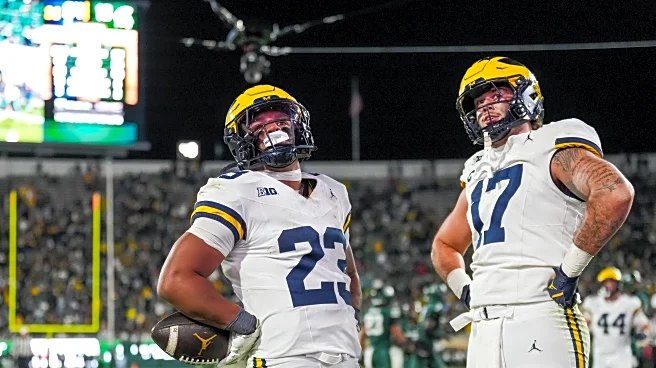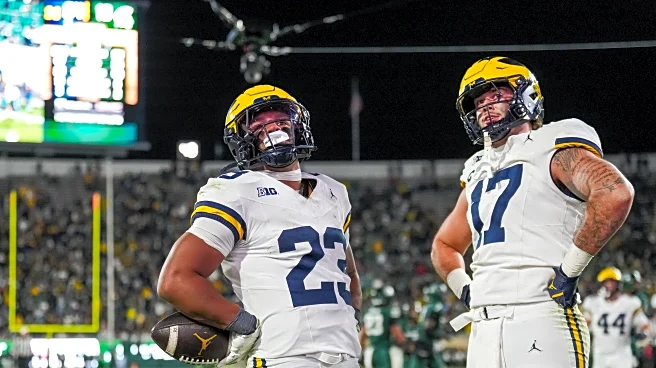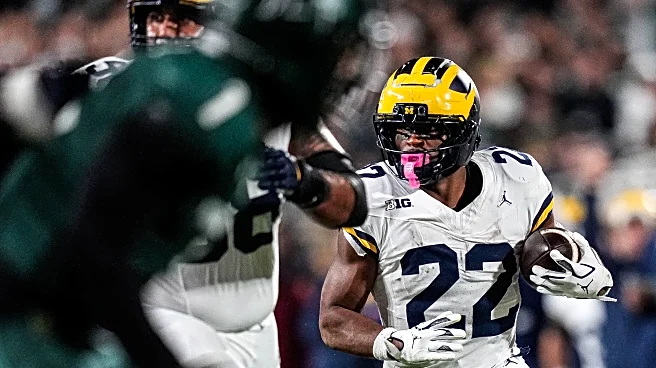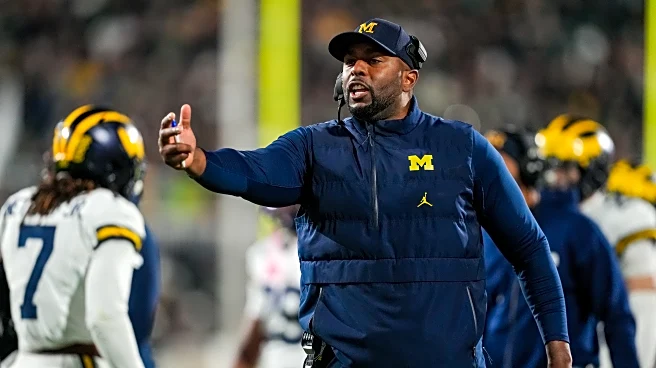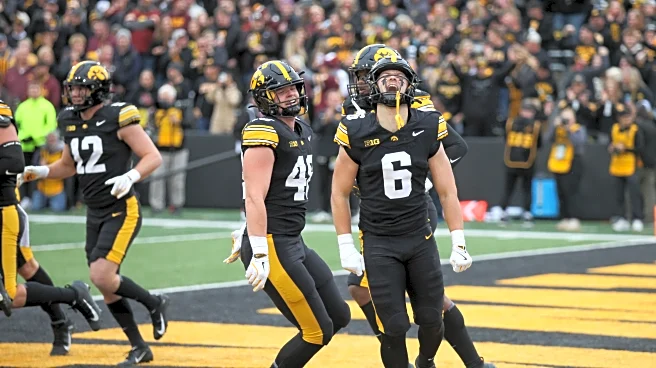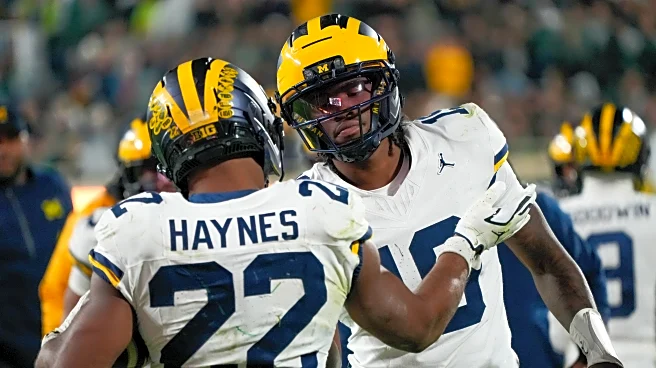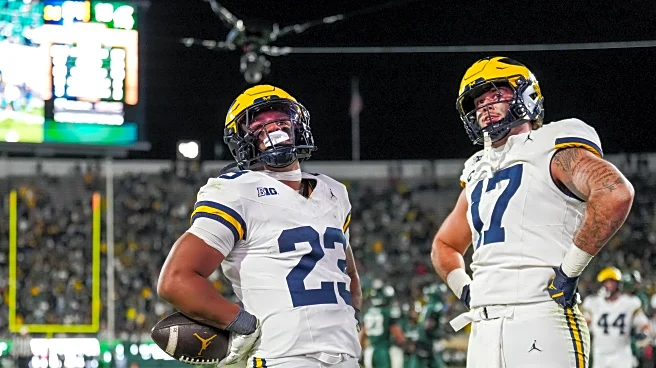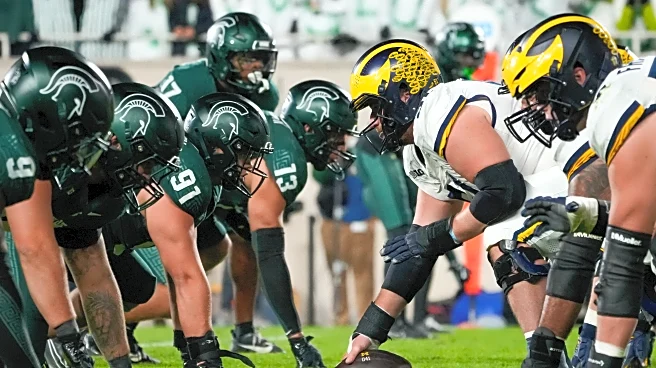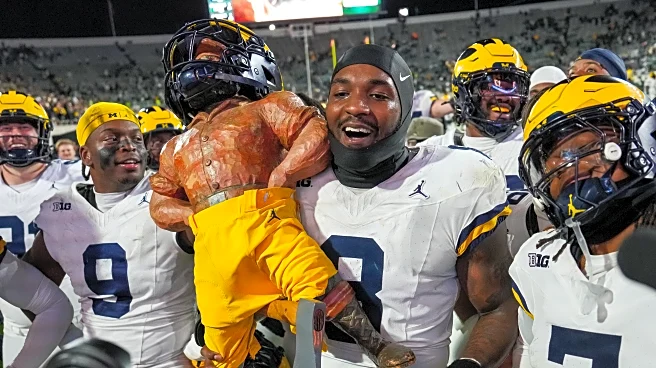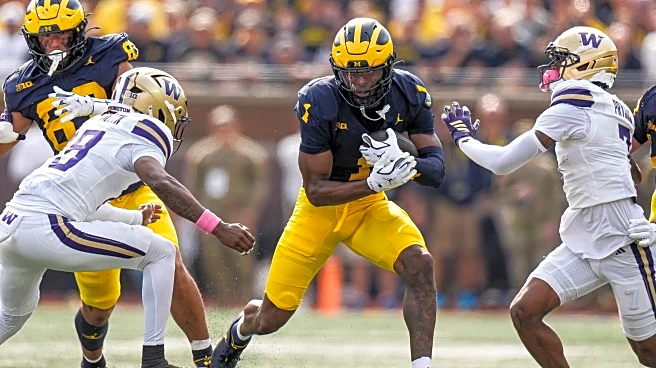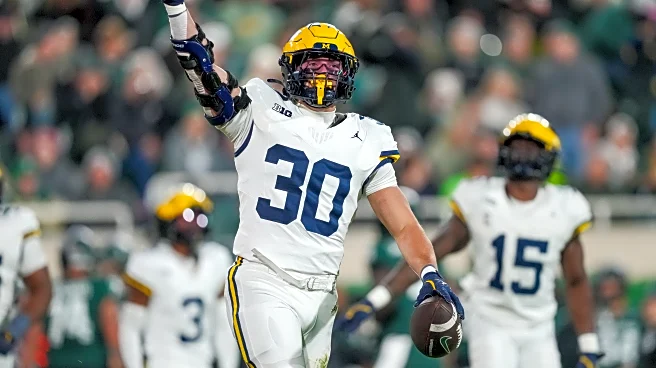Another year, another weird game against Michigan State. “Throw out the records” is a dumb coach-speak cliche, but there is a validity to it within this perennially strange rivalry.
Going back, beyond the
obvious “trouble with the snap” fiasco in 2015, the juggernaut Wolverines of 2016 struggled to ice the eventual three-win Spartans — a game that tonally reflected the one from a few days ago. The 2017 monsoon matchup saw the undefeated Wolverines hold the unranked Spartans to 26 total yards, two first downs and zero points in the second half, yet still lose due to five turnovers and poor game management.
In 2018, Michigan overcame surrendering two fumbles within eight plays of each other (there were actually three fumbles total in this wild sequence, with Michigan State offering one up in the middle) in the second half.
The 2021 contest saw Jim Harbaugh blow the biggest regular-season lead — 16 points — of his Michigan tenure to fall in East Lansing. The tunnel assault of 2022, albeit off the field, equally qualifies as bizarre. And last season, when the Wolverines won despite losing the total yardage battle by nearly 100 yards (this wasn’t one category outweighing the other, Michigan lost in both passing AND rushing), and the time of possession by 15 minutes.
But as it has been the last four years, the Wolverines were able to withstand the weird on Saturday, emerge victorious and extend their longest winning streak over the Spartans since they won six straight between 2002-07. Sherrone Moore is the only Michigan head coach since 1950 to beat Michigan State twice to begin his tenure, and Moore moves to 5-0 against rivals — Ohio State, Michigan State and Minnesota (I credit Moore for the 2023 win over Ohio State, even if history does not).
Michigan overcame its worst passing outing of the season to claim victory. Lost in the criticism of the pass attack that has emerged from this performance is the fact the Wolverines rushed for their most yards against Michigan State since 1994. We’re talking the Clinton administration, pre-Monica, with two running backs — Tyrone Wheatley and Tim Biakabutuka — who would both be first-round draft picks.
To channel my inner Jim Harbaugh, “Heard a little bit of noise about it. ‘Why so much running? You gotta throw more.’ That kind of thing. There’s a lot of ways to travel. Some people choose to travel on the ground, some people by air. George Patton was able to get his job done on the ground. Neil Armstrong through the air. Last Saturday night, we chose to grind it out on the ground and were also able to get our mission accomplished. Lot of ways to expand. Play action. You want your opponent to know and understand there are multiple ways, and they know, to travel.”
Let’s check the tape for a closer look at how the Wolverines got it done on the ground and why this change in travel was necessary.
13-Personnel Double Bluff Zone
Marching down the field on their second drive of the game, offensive coordinator Chip Lindsey drew up a beautiful play for Michigan’s first touchdown. Bringing in three tight ends, Michigan stacked all three to the bottom of the formation, with wide receiver Channing Goodwin aligning in a cut-split into the boundary.
Before the snap, the two tight ends off the ball — Jalen Hoffman and Max Bredeson — go into motion, and here’s where the magic happens. Both Hoffman and Bredeson are both going to “bluff” the defensive end.
What does that mean? It means they are going to pretend to block him — selling the idea of a split zone run play — and then running around him. First, it’s Hoffman and then Bredeson bluffing, and you can already see the edge off balance. Now, it’s up to Bryce Underwood to read the defender. If he keeps contain or blows the bluffing up, he will hand this ball off to running back Justice Haynes. If the defender crashes, Underwood will pull it and hit the perimeter.

To his credit, the edge tries to play both, but after Underwood’s shoulder fake, he stood no chance. Underwood gives him a little hesitation, hits the outside with two lead blockers, and 18 yards later, hits the Paul Bunyan pose. Later in the game, Lindsey would return to this exact same play from the opposite hash. Except this time, Underwood gave the ball to Haynes, who breaks contain, and, 14 yards later, strikes a pose of his own.

11-Personnel GT Counter RPO
Michigan’s offense had stagnated in the second quarter. Entering recess, Underwood had less than 60 yards passing and the offense was completely out of rhythm. In need of a spark, Lindsey went back to Michigan’s gap-scheme roots, with a slight variation of aligning with 11-personnel to help lighten the box.
The first play out of the half was a classic trap play that sprung Haynes for 20 yards. At the risk of overthinking or getting cute, Lindsey instead dialed up a steak-and-potatoes run play as the immediate follow-up: Counter. Maybe only out-called by Duo, Counter is one of Michigan’s foundational run plays. The play that helped bring a pair of Joe Moore awards to Ann Arbor and end the 10-year drought against Ohio State in 2021.
Sticking with 11-personnel, Michigan comes out with trips to the bottom of the formation and tight end Marlin Klein in-line to the top. Goodwin goes in glide motion across the formation, settling in right before he reaches Klein. This motion is vital to the success of this play because the boundary corner, originally with no one to his side, was going to activate and blitz off the edge. But with Goodwin coming across, the corner now has a new assignment.
At the snap, right tackle Andrew Sprague and right guard Jake Guarnera pull and the rest of the line gets to work down-blocking. Center Greg Crippen has a hard assignment, reaching the 2i defensive tackle, and despite largely missing, he is able to push him just enough to prevent the play from falling apart. Also, thank you to Justice Haynes for not wasting any time.
Left guard Giovanni El-Hadi easily seals the other defensive tackle and left tackle Blake Frazier forgoes the defensive end and works to the backside linebacker. Klein works up to the safety and Goodwin (who had a really solid day blocking) wipes out the corner from play. On the pull, Guarnera cleans up the vacated defensive end and Sprague seals the strong side linebacker to the sideline. Bing, bang, boom.

An RPO tag was added to this call with Andrew Marsh flashing for a bubble, but this was a no-brainer “give” read for Underwood. Haynes quickly takes the ball to the second level, sheds a diving arm tackle from the backside linebacker and picks up 28 yards before being brought down by the free safety.
This isn’t quite teach tape, but this is an exquisite rep from the offensive line and spoke to a critical adjustment in the second half of pounding the rock.
But why was Michigan so committed to the ground game? What about Underwood? He is a super talent. But he is also a true freshman. And three plays later, we were reminded of that fact.
11-Personnel Sluggo vs. Simulated Pressure
Facing a third down, the Wolverines come out with 11-personnel and align wide receivers Donaven McCulley and Semaj Morgan to the field side, and tight end Zack Marshall and wide receiver Andrew Marsh into the boundary. The play is designed to sell the double slant with Morgan and McCulley, before having Morgan turn his route into a sluggo (slant and go). On the backside, Marsh is simply clearing out and Marshall is running a curl. Why plays are still being drawn up for Morgan at this point is beyond me, but I digress.
To counter, Michigan State defensive coordinator Joe Rossi shows a six-man blitz pre-snap and even walks up a nickel late to the line of scrimmage for a seventh, with two deep safeties. In the slot, the unsure-handed Morgan does an excellent job of pointing out the nickel — a pressure Rossi has already brought a handful of times to this point — and Underwood looks over to see it.

Immediately, Underwood should know that 1) the defense is going to drop into zone, 2) the nickel is coming HOT, 3) Morgan is uncovered, and 4) the play call is perfect to exploit this. With the regularity of the nickel pressure, Underwood should have changed the protection or at least flipped running back Jordan Marshall to the nickel’s side if he was uncomfortable. But if nothing changes, he has to be prepared to stand in and attack the missing corner before a defender can replace him in coverage. But instead, Underwood panics and tries to buy time by retreating to hit Marshall on the curl.
At the snap, Rossi only brings four (including the nickel), drops three defenders into coverage, and runs a twist on the inside. Right tackle Andrew Sprague and right guard Jake Guarnera showcase the communication skills of a divorced couple struggling to pick up the movement, forcing Marshall to step up to block the most dangerous man. Left guard Giovanni El-Hadi and center Greg Crippen block air and look for work with the urgency of James Franklin. And left tackle Blake Frazier is isolated and struggling to defend a speed rush on the perimeter. It is at this point Underwood realizes he screwed up.

Now, Underwood should sail this ball out of bounds or out of the end zone, but he elects to double pump and pray something opens up at the last minute. When he finally pulls the trigger, the nickel makes contact, forcing a fumble. Fortunately, the nickel was whistled to have jumped early, saving Underwood and the drive.
Michigan’s offensive line didn’t do Underwood any favors on this play, but if read and executed correctly, this should have been a first down. That is, assuming Morgan catches the ball. On Michigan’s next drive, Underwood’s inexperience would again come into play.
11-Personnel Snag Concept
Facing another third-and-long, Rossi continues to play mind games with the young quarterback. Michigan State again walks up seven defenders near the line of scrimmage and even stacks the nickel over tight end Marlin Klein to sell the blitz from the perimeter. When defenders are stacked like this, it usually indicates one is blitzing and the other is replacing them in coverage.

Michigan comes out in a 3×1 look with McCulley isolated into the boundary, and Klein, Morgan and Marsh split out to the field. McCulley is going to run a Go route to clear out the backside and serves as a desperation option if everything goes to hell. Play-side, the Wolverines are going to run a snag variation with Marsh running the snag (slant-curl), Klein running the arrow route (with a chip-release) and Morgan running the post.
Typically, Snag concepts will feature a corner route, but it wouldn’t surprise me if the route changes based on safety alignment, and with split safeties, the post is more advantageous. The corner/post is typically only thrown as an alert if the look is good pre-snap. The read here is traditionally arrow and then snag, but with the delay of Klein, the read should be Marsh and then Klein. Unfortunately, Underwood never makes a read because he made up his mind pre-snap that he was taking off.

At the snap, the defense drops eight players into coverage with three deep and five underneath. There are only three rushers (credit to Rossi’s design here, bringing the near-side edge defender on a looping rush to simulate a blitz), and the Wolverines pick them up cleanly to create a great pocket for Underwood to throw. Marsh draws the attention of three defenders and Klein is WAO (wide ass open) the moment Underwood hits the top of his drop. All Underwood has to do is make his read.

In a panic, Underwood tucks and runs against the worst possible defense to tuck and run against. He is easily tackled before the first down and Michigan is forced to punt.
On Saturday, Underwood played like a true freshman, and that’s okay. Michigan’s run game was there to support him and, most importantly, get the victory. Games like this will help expedite Underwood’s long-term growth, but development is never perfectly linear. Look no further than junior Oregon quarterback Dante Moore.
Moore has been heralded as the best pure passer and quarterback in college football by analysts such as Todd McShay ($), but he threw for less than 90 yards against Wisconsin’s putrid pass defense at Autzen, a Wisconsin defense Underwood threw for 270 yards against earlier this month.
There is always a tax to be paid for starting a true freshman quarterback, and Michigan’s has been relatively low compared to most. Underwood contributed on the ground and protected the ball to help Michigan move to 6-2. In a rivalry dominated by the weird and unpredictable, if the strangest thing that happened on Saturday was “true freshman plays like true freshman,” it was worth getting the job done like Patton intended.
